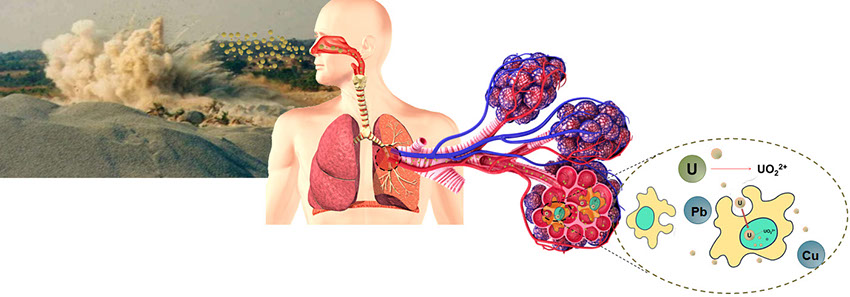Toxicity, Mechanisms and Human Health Effects of Airborne Heavy Metals
Across the world, inhalation of aerosol dust containing toxic metals has elevated health issues for millions of people. In the south west of United States, the desert dusts contain considerable amount of heavy metals such as zinc, copper, lead, arsenic, chromium and nickel in their oxide forms. The mining across the nation, especially in the south west, introduces other toxic oxides such as uranium and thorium to the dust. Even though recent biomedical research correlates respiratory disorders to heavy metals, their lethal concentrations for inhalation, correlation to mineralogy and synergistic effects are poorly understood. Here, we hypothesize that the chemical toxicity of airborne heavy metals depends on their ability to dissolve in lung fluids and subsequent uptake of substitute metals by biological systems thereby interrupting their biological functionality. The overall goal of this work is to study the bioaccessibility of toxic metals from wind-blown dust via inhalation and evaluation of lethal concentrations under various environmental and geological conditions. We carry out this research in collaboration with Dr. Daniel Cadol (Hydrology, NMT) and Ms. Bonnie Frey (Bureau of geology, NMT).
In our work related to airborne uranium, we quantified the dissolution of authentic aerosol dust collected from various uranium mining sites, i.e. Jack pile mine, San Juan mine, in two body fluids. This was followed by in vitro toxicological studies using lung tissues and macrophages. We observed that the respirable dust containing uranium minerals that yield the uranyl cation, UO22+, as the primary dissolved species in these fluids. Moreover, we use geochemical modeling, such as PHREEQC, to test the solubility of these minerals under simulated conditions. Thus, our work highlights the importance of site-specific toxicological assessments across mining districts with the focus on their mineralogical differences. You can find more details of some of this work in Environmental Science and Technology Letters.

Particles < 10 mm has 50% probability to reach alveoli region
Ligand-promoted U dissolution governs the surface chemistry, and its toxic effects. “Site-specific Risk Assessments”
ADMINISTRATIVE ASSISTANT
GAYAN R. RUBASINGHEGE
Associate Professor of Chemistry
New Mexico Institute of Mining and Technology
Department of Chemistry
801 Leroy Place
Socorro, NM 87801
Bethany Jessen
New Mexico Institute of Mining and Technology
Department of Chemistry
801 Leroy Place
Socorro, NM 87801
Phone: 575-835-5129
Fax: 575-835-5215
Phone: 575-835-5263
Fax: 575-835-5364
Copyright © 2018 The Environmental Chemistry Research Research Group. All rights reserved.